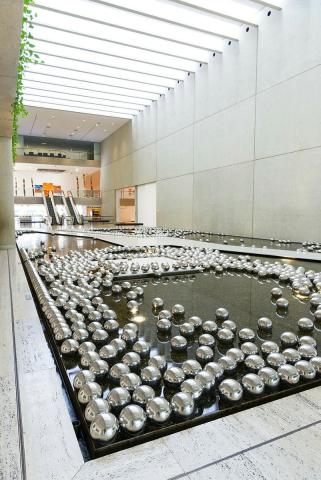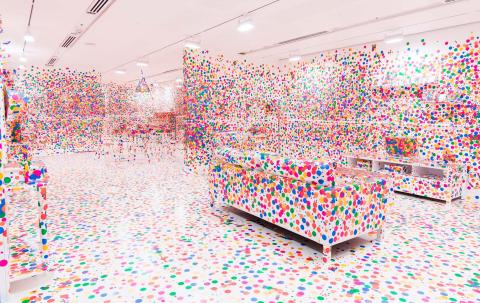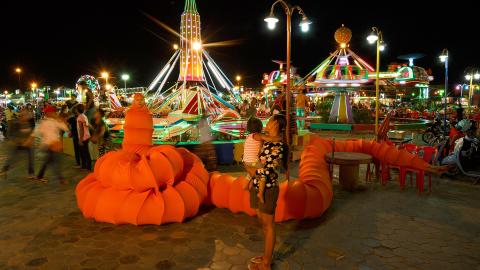APT4–5
The Asia Pacific Triennial of Contemporary Art
APT 2002 (APT4)
The fourth APT was a radical departure from the format of the earlier exhibitions, instead focusing closely on the work of a smaller group of contemporary artists. Though the exhibition was still mounted on a grand scale, the Gallery chose to explore the careers of fewer artists in depth, rather than present artists country by country. Those selected had made — and, in many cases, continue to make — profound contributions to modern culture. As then curatorial lead Suhanya Raffel wrote at the time, ‘In their hands, modernity is both a condition that is resisted and a constant source for experiment and invention’. APT 2002 was largely inspired by the longstanding contributions of three key international avant-garde figures: Nam June Paik, Yayoi Kusama and Lee Ufan.

Yayoi Kusama’s Narcissus garden 1966/2002 installed in the QAG Watermall for APT4, 2002 / Stainless steel balls / Gift of the artist through the Queensland Art Gallery Foundation 2002 / Collection: QAGOMA / © YAYOI KUSAMA / Photograph: QAGOMA
APT4 Highlights
Visitors may recall a performance by Pasifika Divas — a collective including fa'afafine performers, designers and artists from Pacific Islander communities in Aotearoa New Zealand — in QAG’s Sculpture Courtyard. (Fa’afafine is a Samoan term for those who self-identify as having a third or non-binary gender.) The Pasifika Divas were a major component of the opening program. Yayoi Kusama’s reflective Narcissus garden 1966/2002 installation in the QAG Watermall was also highly popular, as were her Soul under the moon 2002 and The obliteration room 2002–ongoing installations, which made their first appearances at the Gallery during this APT.
APT 2002 artists were Montien Boonma, Eugene Carchesio, Heri Dono, Joan Grounds, Ralph Hotere, Yayoi Kusama, Lee Ufan, Jose Legaspi, Nalini Malani, Nam June Paik, Pasifika Divas, Lisa Reihana, Michael Riley, Michael Min Hong Lin, Howard Taylor, Suh Do-ho and Song Dong.

Yayoi Kusama’s perennially popular work The obliteration room 2002–present / Furniture, white paint, dot stickers / Collaboration between Yayoi Kusama and Queensland Art Gallery. Commissioned by Queensland Art Gallery. Gift of the artist through the Queensland Art Gallery Foundation 2012 / Collection: QAGOMA / © YAYOI KUSAMA / Photograph: QAGOMA

Artist Lee Ufan during installation of his work Relatum 2002 for APT 2002, QAG / Iron plates, stones / The Kenneth and Yasuko Myer Collection of Contemporary Asian Art. Purchased 2002 with funds from The Myer Foundation, a project of the Sidney Myer Centenary Celebration 1899–99, through the Queensland Art Gallery Foundation / Collection: QAGOMA / © Lee Ufan / Photograph: QAGOMA

Narcissus garden 1966/2002
- KUSAMA, Yayoi - Creator

Soul under the moon 2002
- KUSAMA, Yayoi - Creator
'The 5th Asia Pacific Triennial of Contemporary Art' (APT5)
The case for the construction of the Gallery of Modern Art (GOMA) — a major new museum not just for Australia but also for the Asia Pacific region, which would double the available space and offer unprecedented opportunities for ambitious installations — was strongly influenced by the success of the Asia Pacific Triennial. When GOMA opened in late 2006, APT5 was its inaugural exhibition. Some 350 works by 35 individual artists, filmmakers and performers were hosted across the two sites, along with two multi-artist projects: The Long March Project, which opened a window onto China; and the Pacific Textiles Project. The new Australian Cinémathèque established our commitment to moving image and new media works, while Kids' APT5 found its home in the new multi-level Children’s Art Centre, where young visitors engaged with works on display and were guided around the exhibition by APT5 mascot Scoots, the green turtle.

A moment from ‘Kin’, created by Stephen Page and performed by Bangarra Dance Theatre during the opening weekend of APT5, 2006 / © The artists / Photograph: Jo Bell
APT5 Highlights
Visitors were stunned by Ai Weiwei’s Boomerang 2006, installed in the Watermall for the first time; while the lifelikeness of Bharti Kher’s sculpture The skin speaks a language not its own 2006 elicited marvel as well as melancholy. Tsuyoshi Ozawa’s ‘vegetable weapons’ became an icon of the Triennial and of the Gallery’s Asian and Pacific collection; and many will recall the moving opening-weekend performance of ‘Kin’ by Bangarra Dance Theatre, choreographed by artistic director Stephen Page.

Bharti Kher’s sculpture The skin speaks a language not its own 2006, installed at QAG for APT5, 2006 Fibreglass and bindi / Purchased 2007. Queensland Art Gallery Foundation / Collection: QAGOMA / © Bharti Kher / Photograph: R Hassett, QAGOMA
APT5 artists included Khadim Ali, Jackie Chan, Beck Cole, Justine Cooper, eX de Medici, Jitish Kallat, Anish Kapoor, Sutee Kunavichayanont, Kwon Ki-Soo, Dinh Q Le, Hong Hao, Liu Jieqiong, Mu Chen and Shao Yinong, Qin Ga, Wang Wenhai, Zhou Xiaohu, Djambawa Marawili, Nasreen Mohamedi, Tuan Andrew Nguyen, Dennis Nona, Eko Nugroho, Paiman, Michael Parekowhai, John Pule, Nusra Latif Qureshi, Rashid Rana, Sangeeta Sandrasegar, Talvin Singh, Michael Stevenson, Masami Teraoka, Yuken Teruya, Sima Urale, Apichatpong Weerasethakul, Yang Fudong, Yang Zhenzhong and more.

Eko Nugroho's site-specific installation It’s all about the Destiny! Isn’t it? 2006 at GOMA for APT5, 2006 / Synthetic polymer paint on MDF board / © Eko Nugroho / Photograph: Natasha Harth, QAGOMA
Learn more

Digital Story Introduction
LOOKING BACK AT THE APT‘The First Asia Pacific Triennial of Contemporary Art’
Read digital storyDigital story context and navigation
LOOKING BACK AT THE APTExplore the story

Digital Story Introduction
LOOKING BACK AT THE APT‘The First Asia Pacific Triennial of Contemporary Art’
Read digital storyAbout this page
Related resources





